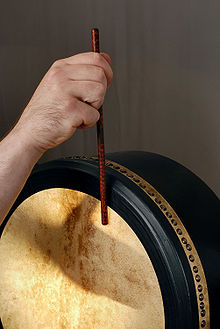Bodhran
Bodhrán ([ ˈbɔːrɑːn ] or [ ˈbaʊrɑːn ]) is an Irish frame drum .
The diameter of a bodhrán ranges from 20 cm for very small specimens to 50 cm for very large specimens. The frame is covered with fur (often goat skin ) and reinforced with a cross if necessary. For the players, playing with or without a cross is a matter of taste. Originally, the cross was intended to increase the stability of the drum , as the frame could possibly give way under the tension of the skin. A good bodhrán does not necessarily need the cross. Modern bodhráns have a mechanical tuning system with which the player is able to influence the pitch of the head. Good heads can be tuned to precisely defined basic tones (according to the music usually D or G).
history
The origin of the name bodhrán and its history can now be better reconstructed than a few years ago, even if not all questions have been answered. The name comes from the Irish word bodhar , which can mean deaf, dull, dazed or dull. The word bodharaí means a hollow tone, the sound of a drum, and so on. Incidentally , the word bodhar has been derived from the word bodhar since the Middle Ages. Word "to bother" from. Bodhar is no longer in use today. The earliest evidence of the use of the word bhodhrán goes back to a 15th century script, medical instructions in which a distended stomach is described with the sound of a drum (bhodhrán). Old encyclopedia entries also show that the word bodhran was already in use before 1827. In pictures by an Irish painter (Maclise), which were made around 1850, you can see a frame drum in which the left hand of the player touches the inside of the skin and the right hand seems to perform the typical movement. An origin from the word bell drum "Tam bourine " is unlikely.
The frame drums may have come to Ireland through early trade routes. Frame drums are represented all over the world and may have evolved from sieves used in early agriculture.
As further research has shown, some bodhran manufacturers were found in some areas of Kerry as early as the 1920s, who built not only for local musicians but also for tourists, so the bodhrán was already a popular souvenir back then. A first recording is known from 1927, at least one hears the flute and drum there, whether it is a bodhrán with bells or a tambourine is not known. The bodhrán's popularity has risen steadily since the 1950s and 1960s thanks to bands like The Chieftains , Planxty and Stockton's Wing. Despite its Irish origins, the bodhrán is enjoying growing popularity with regard to Celtic music, especially in Scotland and Newfoundland .
Playing techniques
The bodhrán is usually played while sitting, standing on the player's thigh. The right-hander touches the inside of the head with his left hand and can vary the pitch or achieve dampening effects by applying pressure and different hand positions. The bodhrán is played with the right hand with a wooden mallet , the tipper , beater or stick .
When it comes to strokes, a distinction is made between upstroke and downstroke , i.e. between "serve" and "discount". The tipper is moved over the skin in a rotating motion. To add decorations , you can also do a double strike, during which the upper part of the tipper also touches the skin during the downstroke (roll or triplet) and thus creates the unmistakable sound of the bodhrán .
That being said, each player's style of play varies a bit in the details. For example, one speaks of
- Kerry style in which the tipper is held between the thumb, index finger and middle finger (or thumb, middle finger and ring finger) like a pen. In addition, this style describes a way of playing that focuses a little more on mere rhythm than, for example
- Top-end style . This refers to the point where the stick is attached, which in this style is not at the bottom or in the middle of the head like the others, but at the top. In addition, there is an almost vertical stick position. In general, this style allows for a more melodic playing style with a high range .
However, there are also mixed forms of the techniques.
Bodhrán player
Well-known international bodhrán players are Johnny "Ringo" McDonagh , Colm Murphy , Jim Sutherland , Tommy Hayes , Seamus O'Kane , Mel Mercier , Junior Davey , Frank Torpey , Eamon Murray , John Joe Kelly , Svend Kjeldsen , Caroline Corr , James McNally and Dave King . Some German bodhrán players are Klaus Gehrmann , Esther Kuck , Guido Plüschke , Thórralf Schuh , Rolf Wagels , and Thomas "Pínto" Heuer .
Bodhrán manufacturer (selection)
Albert Alfonso, Metloef (each from the USA), Charlie Byrne, Seamus O'Kane, Darius Bartlett, Malachy Kearns (each from Ireland), David Gormlie (Scotland), Norbert Eckermann (Austria), Brendan White (Netherlands), Christian Hedwitschak David Roman (both from Germany).
literature
- Moritz Lange: Handbook for Bodhrán Players. Schell Music, Hamburg 2004.
- Moritz Lange: Bodhrán - the Irish frame drum. In: New Musicological Yearbook. 13th year, 2005, pp. 175-189.
- Conor Long: Absolute Beginner's Bodhran Tutor. 1998, ISBN 1-85720-080-2 .
- Michael O'Suilleabhain: The Bodhran: An Easy to Learn Method for the Complete Beginner Showing the Different Regional Styles and Techniques. Waltons, 1984, ISBN 0-7866-1594-X .
- Steafan Hannigan: Bodhrán Basics. 1996, ISBN 0-946005-87-7 .













